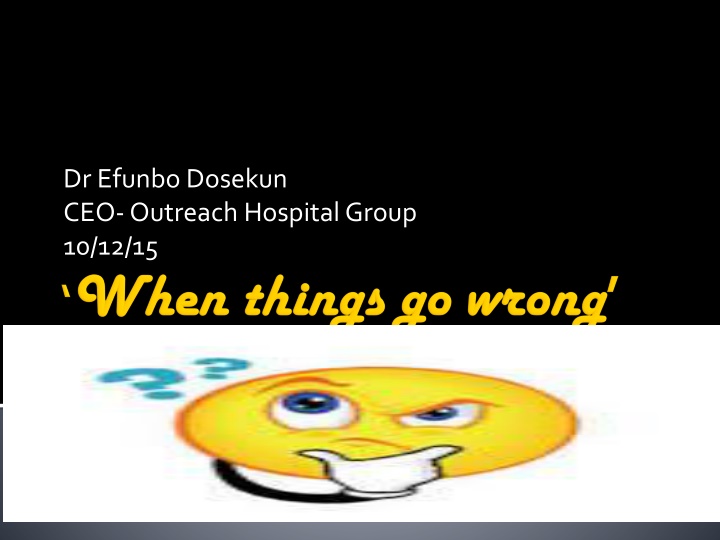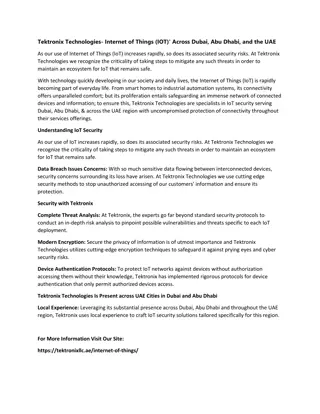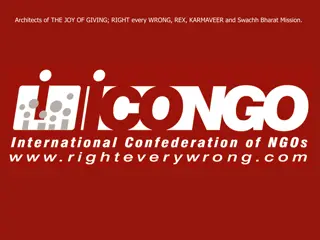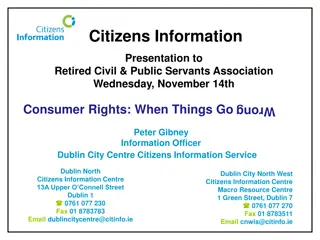
Handling Medical Errors and Disclosure in Healthcare Settings
Understand the nuances of disclosing medical errors to patients and the ethical implications involved. Learn about harmful incidents, near misses, open communication practices, and the process of initial disclosure and management support post-analysis in healthcare.
Download Presentation

Please find below an Image/Link to download the presentation.
The content on the website is provided AS IS for your information and personal use only. It may not be sold, licensed, or shared on other websites without obtaining consent from the author. If you encounter any issues during the download, it is possible that the publisher has removed the file from their server.
You are allowed to download the files provided on this website for personal or commercial use, subject to the condition that they are used lawfully. All files are the property of their respective owners.
The content on the website is provided AS IS for your information and personal use only. It may not be sold, licensed, or shared on other websites without obtaining consent from the author.
E N D
Presentation Transcript
Dr Efunbo Dosekun CEO-Outreach Hospital Group 10/12/15
Harm an unintended event When things go wrong
Non medical harm Medical harm Harm
Harmful incident- unintended harm resulting in death, disability, injury ,longer hospital stay No harm incident-incident occurred but did not harm the patient Near miss-an incident almost occurred but did not reach the patient
Open communication in an honest manner when things go wrong with health care delivery
Internal team Incident Harm Patient/Car egivers Disclosure
How do I decide whether to tell a patient about an error? Do physicians have an ethical duty to disclose information about a medical error? Would disclosing make patients undermine their trust in the physician and the medical system? By disclosing a mistake to my patient , do I risk having a malpractice suit filed against me? What if I see someone else make a mistake?
Initial Disclosure Post analysis Immediate May involve several meetings After investigation
Healthcare provider led Analysis of event Leadership participate or would provide advice Harm from progression of disease Health Associated event Different combination can occur Patient safety incident Harm from recognized risk- inv. +RX
Initial Disclosure Management support/may be several meetings HCP lead Post analysis disclosure Management led HCP may be involved
Words Non verbal behavior- gestures, facial expression, tone/pitch/pac e of voice Sincerity Apology Not an admission of legal liability Acknowledge ment after investigation
Harmful incident Always disclose Patient safety incident No harm incident Usually not disclose Near Miss
Management led Healthcare Provider may be present Legal representation Patient informed on improvement so it does not happen again Acknowledgement of representation
Resolution Civil Liability Criminal Liability Professional Liability Organizational retailation
To err is human, to forgive divine Alexander Pope 1688-1744 Justifying a fault doubles it-A French proverb
Adverse events in 1 in 25 to 1 in 30 of hospitalised cases in USA 1 In 9 to 1 in 12 die 50% 0f adverse deaths preventable 44,000-98,000 die each year
Provider performance System Failure
Clinical Knowledge Procedural Skills Communication skills ICT skills Assertiveness Interpersonal skills
Active Error Human Error Negligence
Failure to give prompt attention to a patient Manifest incompetence in clinical assessment Wrong diagnosis in presence of obvious clinical presentation Fails to advice on risk attendant to conditions or intervention Makes glaring mistakes By action or omission makes other members of the health team to cause harm
In the Nigerian case of Diamond Bank Ltd v Partnership Investmentco Ltd, 32 the Supreme Court of Nigeria defined negligence thus: (Negligence is generally defined as the failure to exercise the standard of care that a reasonable prudent person would have exercised in a similar situation; any conduct that falls below the legal standard established to protect others against unreasonable risk of harm.. per Ogbuagu JSC pp 52-53 Negligence is a question of fact and each case depend upon its own perculair facts and circumstances. Babalola Abegunde AJHSS Vol1- 3,Nov 2013
Medical negligence law covers the consequences for medical practitioner s non-exercise of appropriate care and rights of patients when a medical practitioner makes an error or fails to provide an acceptable level of care in the execution of his duty. This is called fault liability . Negligence has been defined by Baron Alderson in the case of Blyth v Birmingham Water Works as: the omission to do something which a reasonable man would do or doing something which a reasonable or prudent man would not do. 34. Babalola Abegunde AJHSS Vol1-3,Nov 2013
Registrar of British Colombia 2004 Only 1% of complaints rose to the level of disciplinary action. Virtually all those actions were related to conduct violation. In the past 12yrs no case has come to discipline on grounds of medical errors alone Seland 2004
ERROR EXAMPLE 1 Diagnosis or evaluation Missed Diagnosis 2 Medical Decision making Inappropriate premature discharge 3 Treatment Delay in Treatment 4 Medication Wrong dosage or drug/expired drug 5 Inadequate supervision Failure to review plan 6 Faulty Communication Poor intrateam communication/poor patient communication 7 Procedural competence Faulty technique
Patient falls Unsafe use of medical equipment incorrect handove r Misdiagnosi s Unsafe interface: equipment + providers Unsafe injection s Unsaf e blood Health care- associated infection Unsaf e surge ry Unsafe use of medicatio n Poor test follow-up Poor training of health care staff Counterf Worklo ad pressu res eit Stress and fatigue of health care staff WHO Patient Safety drugs Workshop
Poor communication Poor organisational skills Ignorance Hesitation Fatigue
Inexperience Juggling too many balls Lack of assertiveness Forgetfulness Faulty judgment
Error Prevention Examples 1 Reduce reliance on memory Checklists, proforma, Intergrated care pathway/Early warning system 2 Hands off process SBAR/Hand over instruction 3 Error proofing system Fail safe to avoid prescribing 2 drugs that interact 4 Improved information access Electronic patient recording 5 Standardisation Guidelines, Algorithms, protocols(EBM) 6 Training on process mapping/Induction Staff in service 7 Documentation/Signing Detailed notes/informed consent
Open disclosure begins with informed consent and honest discussion of realistic expectation
Equipment Failure Facility design Training process Maintenance culture Financial resources Human resource problems Poor process mapping
Clinical Risk Management Strategy Patient centered care Independent Accreditation Quality improvement strategy Hospital Safety Program Clinical governance
Assess Frequency & Severity Identify Assess the Cost or Impact Reduce or Eliminate
Clinical effectiveness Risk management Patient experience Communication effectiveness Strategic effectiveness Learning effectiveness Resource effectiveness
Public Empowerment Outdated medical practice in Nigeria Variation in care Clinical governance Professional Self regulation Media empowerment Medical litigation
Safety management System Attitude
Aviation Oil and gas Nuclear High safety culture
Is defined as an organisation which has fewer than normal accidents. This occurs through culture change. It expects it s organisation and sub-system will fail and works very hard to avoid failure while preparing for the inevitable so they can minimize the impact of failure
The key difference between HROs and other organizations in managing the unexpected often occurs at the earliest stages, when the unexpected may give off only weak signals of trouble. The overwhelming tendency is to respond to weak signals with a weak response. Mindfulness preserves the capability to see the significant meaning of weak signals and to give strong responses to weak signals Weick and Sutcliffe, 2001
Preoccupation with failure Reluctance to oversimplify reason for problems Sensitivity to operations Commitment to resilience Deference to expertise
Develop a safety culture Leadership engagement Develop champions /identify stakeholders Community involvement and education Incident reporting cycle development
Celebrating safety Safety Video development Developing an organisation with a memory Training-formal, simulation,CPD, Education Occupational Health System Environmental Safety System
Calculative Reactive-Safety is imp..We do a lot when an accident occurs Imposed.Driven by SMS .Much data collection Proactive Work on problems discovered. Workforce move the initiative from top down approach Pathological Who cares once we are not caught Generative Active participation of all. Inherent part of
Promotion of statutory duty for quality Professional self regulation -MDCN Patient safety program. New accountability structure Statutory body for Monitoring Standards Performance Framework. Patient Survey. National patient safety agency NICE
Development of a National Safety Institute Inclusion in National Health Bill Development of Hospital Policy/ guidelines on Disclosure by experts/patients support stakeholders inclusion Medical Defence-hospital/professional Professional regulation More Education for all














